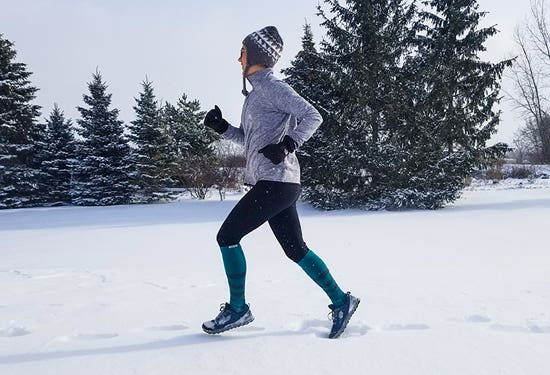6 ways you can take on winter running without wanting to go back to bed
If you’re a runner living in the northern part of the United States, you likely experience the full four seasons—meaning you definitely experience the joys of winter. And not the southern California chill Injinji comes in contact with, you get the real deal. Snow, ice, slush, it’s all out there and you have the opportunity to run through it!
We know, of the first words that come to mind when you’re thinking about your winter running routine, “opportunity” may not be one of them. But why not? With the right tools, and a few handy tips and tricks, you’ll not only stay safe while you run, winter may become your favorite season to run through. Check out a few of our favorite winter safety suggestions, then try them out for yourself.
- Warm Up & Cool Down
We know you’ve heard it a million times, “Warming up and cooling down are important parts of your runs.” That’s true any time of year, but warm ups and cool downs take on more weight in the winter. Think about it, if your muscles aren’t prepped for a workout, they don’t have the benefit of warm weather to help them get loose. While they may warm up some, it’s going to take a lot longer in subzero temps. And that extra time leaves room for injuries that come from tight muscles. Try this warm up to get in some dynamic stretches before you hit the pavement.
You should also make sure you cool down and recover properly after a run. Work in more dynamic stretching, some foam rolling and even a topical pain reliever if you think you’re going to be sore.
- Phone a Friend
Even if you’re a solo runner the rest of the year, winter is the time to grab a fellow runner. Having another person around not only helps you stay motivated, if you have an issue or start to show signs of hypothermia, they can help.
- Know the Conditions (and When to Stay Home)
Winter is all about being smart to stay safe, which means you’re going to have to be glued to your weather app. Depending on how long your run is, you’ll need to look that far into the future. And always be prepared for surprises: keep a few extra layers in your running bag just in case.
Don’t forget, there’s a time and a place to stay home. If you’re new to winter running or the temps have dropped below 20 degrees (and that includes wind chills!), you may want to stay inside or consider a shorter run. Winter weather is nothing to tangle with, and you’d rather be safe than sorry.
- Get the Right Gear
The pillars of winter running gear? Warm, dry, stable and visible. You want to make sure that everything you’ve got on while you run will keep you feeling this way.
- Clothes
Layers are your friend in the winter. You want to make sure you’re wearing the right amount of clothing for the temperature outside. A good rule of thumb? Cool and dry is better than hot and sweaty (you don’t want your sweaty clothing to freeze and cause hypothermia!). And make sure you’ve got reflective strips on your clothing, so you’re always visible.
- Shoes
So long, lightweight mesh shoes of summer runs! It’s time for something a little more heavy duty (and waterproof). Aim for something warm and sporting a Gore Tex so you can keep from being frozen.
- Accessories
Think old-school mom advice on this one: cover all extremities with warmth. You’re going to need a hat (or headband), scarf, gloves and the warmest snow socks you can find. You want to make sure you’re protecting yourself from hypothermia and frostbite, at any cost.
- Find the Snow, Avoid the Ice
When it comes to winter running, you’re actually going to do better in the snow than any cleared off patches. The snow offers better traction than ice, but you still may want to invest in some traction devices to make yourself even more secure.
- Pick somewhere fun to run
It might be cold, but the snow and ice can be beautiful! Pick a location that gives you a good view of the snowy hills and ice-crusted trees. You’ll have so much fun looking at the scenery, you won’t notice the miles you’ve logged!
- Be Realistic & Know the Signs of Trouble: your miles count as double, treat any wipeouts fast
Remember, winter weather affects your body differently than warmer weather. The cold, dry air makes it harder to breathe, and there is a possibility of both frostbite and hypothermia. So make sure you pace yourself and know the warning signs! There’s no shame in running for a shorter distance or time, in the name of safety.
No matter what you do for your running routine in the winter time, make sure you’re doing it safely. And if you follow our running tips and tricks… the cold may not bother you anyway!









